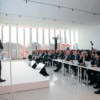In a world where work-life balance is constantly evolving, the concept of blending work and leisure is gaining traction. Whether it’s during a summer holiday on the sunny beaches of the Algarve or Marbella or during an annual corporate meeting organized by top event management companies throughout Europe and the US, the idea of a strict separation between work and relaxation is gaining new contours. More people are embracing a blended approach, where work and relaxation coexist in harmony, leading to a more fulfilling and less stressful life.
Are you a blended work enthusiast?
Imagine this: you’ve just started your two-week holiday on your favorite summer destination.
The first few days feel strange – your mind still races with thoughts of work and there’s a sense of something missing. But as the days go by, you finally enter that relaxed state where work feels like a distant memory. You switch off completely, enjoying the Mediterranean sun, the sangria and the local attractions. But then, reality strikes as your holiday ends. You return to work to find your inbox flooded with emails, red flags of urgent matters and the stress quickly piles up. The tranquility of your vacation is replaced by the overwhelming feeling of catching up.
Now, consider an alternative. Instead of completely disconnecting, you check in occasionally during your holiday. You touch base with your work, skim through emails and ensure no urgent issues need your attention. This approach allows you to stay in the loop without being overwhelmed when you return. This is the essence of the blended work approach – a balance between relaxation and staying informed, which can reduce stress and make the transition back to work smoother.
Blending work and leisure: the silver lining of boring times
The concept of blended work isn’t just for holidays. It’s increasingly being adopted in everyday work-life balance. It’s about integrating work into your life in a way that doesn’t feel intrusive but rather complementary.
This approach recognizes that creativity and productivity often come from moments of relaxation and introspection – like those quiet moments on the beach where your best ideas for the next company meeting might surface. The moments of apparent boredom.
Interestingly, this approach can also be applied to corporate meetings and retreats. While some employees eagerly anticipate these events as a break from their daily routines, others find them disengaging or even boring; and just as some people thrive on complete disconnection during holidays, others prefer to stay connected.
The same goes for meetings. Some employees need the structured, goal-oriented environment of a traditional meeting, while others benefit from the freedom to let their minds wander and come up with creative solutions. The key is to recognize that there’s no one-size-fits-all approach.
Unboring corporate meetings with blended strategies
So, how do we make corporate meetings and retreats more engaging for everyone? By embracing a blended approach.
/ Encourage Flexibility
Just as blended work allows for occasional check-ins during holidays, meetings can incorporate flexible attendance options. Virtual participation, smaller breakout sessions, or even asynchronous discussions can help cater to different work styles and preferences. [Senior Executive] highlights that flexibility is key to meeting engagement.
/ Foster Creativity Through Boredom
It’s okay to allow moments of “boredom” during meetings. These moments can be crucial for creativity. Just as the best ideas might come to you in the shower or while staring at the sky, providing unstructured time during a retreat can lead to out-of-the-box thinking. According to [TravelPerk], fostering creativity through downtime is essential for productive meetings.
/ Recognize Diverse Needs
Understand that your team members have different ways of engaging with work. Some may need quiet time to recharge, while others thrive on constant interaction. A blended approach to meetings offering a mix of activities, from structured brainstorming sessions to free time for reflection, can address these varying needs. This approach is supported by research from [Harvard Business Review].
/ Incorporate Interactive Elements
Incorporating gamification and “choose your own adventure” activities into meetings can make them more engaging. These strategies address the emotional need for interaction and control, making participants feel more invested in the content. [Senior Executive] and [TravelPerk] recommend these tactics to boost engagement.
/ Use Extended Reality and Technology
Embracing technologies like extended reality (XR) can enhance engagement and information retention. For example, interactive holograms or 3D models can make presentations more dynamic and memorable. [Cvent’s Event Statistics 2024] indicate that innovative technology usage is a key trend for successful events.
/ Engage External Facilitators
Bringing in outside speakers or facilitators can ensure that meetings remain dynamic and focused. This not only injects fresh perspectives but also prevents the meeting from becoming monotonous.
/ Offer Virtual Options
Providing virtual attendance options like EMEX, ensures inclusivity and accommodates different preferences and circumstances. According to Cvent, virtual participation can significantly increase the reach and impact of events.
Hybrid Events: More Than Just a Trend
Hybrid events, which blends remote and in-person, has proven to be more than just a temporary adjustment: it’s a fundamental shift in how we operate. But how does this model intersect with the need for in-person meetings?
/ Efficiency vs. Engagement
While virtual meetings can be efficient, they often lack the engagement and creativity that in-person interactions foster.
Research shows that face-to-face communication is 34 times more effective than virtual alternatives, which is why companies still see value in bringing teams together for major events [Harvard Business Review].
/ The Cost of Time Away
Not every organization or employee can afford to spend multiple days away from their regular duties for large meetings.
Hybrid meetings, which combine in-person sessions with virtual attendance options, offer a solution. This approach allows for the critical in-person interaction while still accommodating those who may have time or travel constraints [TravelPerk].
The Blended Approach: Meetings and Beyond
The real challenge lies in finding a balance between these two models leveraging the benefits of in-person interaction while maintaining the flexibility that hybrid work offers. Here’s how companies can adopt a blended approach:
/ Strategic Planning
Not all meetings need to be in-person. Reserve in-person gatherings for activities that genuinely benefit from face-to-face interaction, such as team-building exercises or strategic planning sessions, while routine updates or informational sessions can remain virtual.
/ Flexible Attendance Options
Offer hybrid attendance for large events, allowing employees to choose whether to attend in person or virtually. This not only respects their time but also acknowledges different comfort levels and personal circumstances.
/ Continuous Feedback Loop
Regularly seek feedback on the effectiveness of meetings, both in-person and virtual. Understanding what works and what doesn’t from the perspective of the participants is crucial for continuous improvement.
Reframing Boredom as a Tool for Success
As the workplace continues to evolve, so must our approach to corporate meetings. By integrating emotional thinking methods and adopting a hybrid work model, companies can transform large, potentially boring corporate meetings into engaging, productive experiences. The key lies in understanding and addressing the emotional needs of employees while balancing the benefits of in-person interactions with the flexibility of remote work.
Next time you find yourself or your team facing moments of boredom, whether on holiday or during a corporate retreat, consider reframing it as an opportunity. Boredom can lead to introspection, which in turn fosters creativity and mental well-being.
Let your team know that it’s okay to feel a little disconnected sometimes and that’s when the most creative solutions often emerge. Just ensure that they know how to reconnect and bring those brilliant ideas back to the table.










